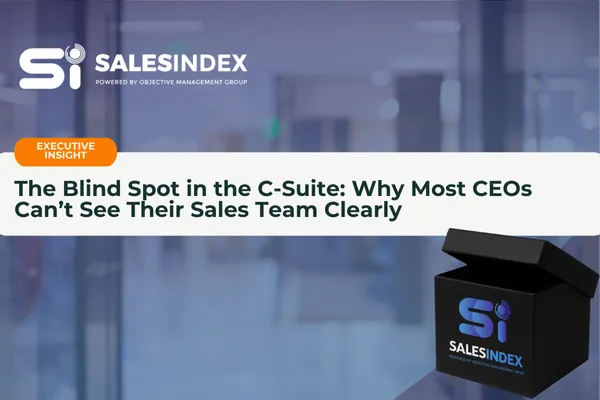404
Oops! We can't find that page.
Here are some helpful ideas we think you'll enjoy!

The Blind Spot in the C-Suite: Why Most CEOs Can’t See Their Sales Team Clearly
TL;DR Executive Summary
Most CEOs can’t see the true potential—or hidden risks—of their sales team.
Dashboards and KPIs only reveal what’s already happened, not what’s possible.
Leading indicators (calls, meetings) help with forecasting but don’t show true growth drivers.
Skillset, mindset, and coachability are invisible in standard reporting, leaving money and performance untapped.
The SalesIndex shows what percentage of your team’s potential you’re actually achieving—and pinpoints where to invest for real growth.
The Discount Factor helps CEOs adjust for reality—measuring the team’s ability and willingness to reach their potential.
Companies like Fischer Group have used SalesIndex to transform culture and drive breakthrough sales growth.
The path: Index your team, develop with data, and grow with clarity—not guesswork.
Introduction: The Illusion of Clarity
If you’re a CEO, you’re used to being in control. You watch the numbers. You read the reports. You talk to your managers. You want growth—faster, more predictable, and more profitable. So why does it so often feel like you’re flying blind when it comes to your sales team?
I’ve sat across from hundreds of CEOs over my career. Some run billion-dollar companies; others are founders of high-growth startups. Almost all of them share a nagging frustration: “I think I know what’s happening in sales…but sometimes, I just can’t see it clearly. And I’m not sure why.”
This isn’t a lack of intelligence or leadership—it’s a systems problem. The tools and metrics that got you here aren’t giving you the whole picture. And that means you could be leaving millions on the table, making costly mis-hires, and missing the breakthrough growth that’s right in front of you.
What you can’t see about your sales team is what’s costing you the most.
Read: The Dangerous Illusion of Sales Performance
I. Why Visibility Is Limited: The Four Blind Spots
For most CEOs, “visibility” into the sales team is mostly an illusion. Closed revenue is a trailing indicator—telling you only what’s already happened. Pipeline and forecasts, meanwhile, often hinge on the gut feel of sales managers and the unreliable quality of what’s actually in the pipeline. The result? You’re left steering by looking in the rearview mirror and trusting instincts, not real insight.
A CEO of an industrial supply company once told me, “We’re making big bets based on data that’s already out of date. By the time we see a problem, it’s already cost us money.” Another president of a wholesale food distributor put it bluntly: “I see the numbers, but I know there’s a whole story I’m missing underneath. And sometimes, I feel like I’m the last to find out.”
This is why so many CEOs struggle to drive real sales growth—they’re managing in the dark, and the real levers of performance are hidden. Here’s where the most dangerous blind spots are lurking:
1. You Only See the Past: Trailing Indicators Dominate
Let’s get brutally honest—most of what passes for “visibility” in the C-suite is just a reflection of what’s already happened. The numbers you see—closed revenue, deals won, quotas met—are all in the rearview mirror. They tell you if your team hit the target, but they don’t help you move the target.
Here’s the real challenge: when you gather your sales leaders each week, what are you really seeing?
Closed revenue only tells you what’s already in the bank. It doesn’t reveal the lost deals, the missed upsell opportunities, or the stalled prospects who quietly disappeared.
Pipeline and forecasts are supposed to be your early-warning system. But too often, they’re built on sales managers’ gut instinct and the questionable quality of the pipeline itself. One manager’s “90% confidence” is another’s wishful thinking.
As I talk with CEO's about their sales potential I hear things like this:
“We’re making big bets based on data that’s already out of date. By the time we see a problem, it’s already cost us money.”
“I see the numbers, but I know there’s a whole story I’m missing underneath. Sometimes, I feel like I’m the last to find out.”
Here’s the danger: Trailing indicators keep you in reaction mode.
You’re stuck diagnosing yesterday’s issues while today’s opportunities and threats slip by unnoticed. You don’t just need to know what happened—you need to know why it happened, and what could happen next.
To move from being a scorekeeper to being a true growth leader, you need visibility into the drivers of sales performance—before the numbers hit your dashboard.
Read: The Dangerous Illusion of Sales Performance
2. Activity Metrics Miss Quality
Realizing that trailing indicators are not enough, many organizations try to get ahead of the curve by scorecarding leading indicators for sales:
Calls made
Emails sent
Meetings booked
Proposals delivered
They also track historical averages such as:
Call to Appointment Ratio
Appointment to Proposal Ratio
Close Ratio
These are a step forward, but they’re also misleading. Quantity of activity and success ratios can help you forecast better, but they don't tell you the full potential of the team or its players. In a sense, the scorecard data uses the past to help forecast the future, but it doesn't give an idea of what a better future could look like.
Here’s the challenge: Activity metrics tell you what’s been done, and success ratios show you the odds of moving a deal to the next stage—but they say nothing about capacity for improvement. You may have a rep making a hundred calls a week, but what if their sales DNA, skills, or coachability mean they could be performing at twice that level with the right support? Conversely, some reps hit their activity targets but consistently miss real opportunities because the quality of their approach is never measured.
Scorecards are built on what’s already happened—not what’s truly possible. It’s like using last season’s stats to guess next season’s results without ever asking, “How good could this player really become if we developed them differently?”
Activity metrics also create a risk of false confidence. You might see a flurry of meetings booked and assume growth is inevitable, when in reality, the conversations lack depth, strategy, or alignment with your value proposition. The team could be busy but not productive—moving, but not advancing.
If you want breakthrough growth, you need to go beyond activity and efficiency and ask the bigger question:
What is this team actually capable of, and how do we help each player reach their best game?
“If you can’t measure potential, you can’t coach it, you can’t replicate it, and you can’t scale it.”
This is where most activity dashboards fail CEOs: they overemphasize volume and ignore potential.
Read: You Can’t Coach What You Can’t See
3. Skills, Mindset, and Heart Are Unmeasured
The truth is, the factors that make the biggest difference in sales are impossible to see in a spreadsheet.
Skillset:
Who can truly sell consultatively, uncovering and solving real problems for clients?
Who relies on price cutting or luck?
Who can negotiate, manage complex deals, or build deep relationships?
Mindset:
Who bounces back from rejection?
Who has the discipline to prospect when times are good?
Who carries a growth mindset, and who is coasting?
Heartset:
Who is driven by purpose and passion for your mission?
Who is just cashing a check?
Who actually cares about their client’s success?
Here’s the real problem: as a CEO, you have no idea what the full potential of your team actually is. Neither do your managers—or even the individual players themselves.
Without objective insight into the skillset, mindset, and heartset of each person, you’re left making educated guesses, settling for the status quo, and accepting incremental gains when exponential growth could be possible.
Money is left on the table: Top-performers go undiscovered. Underperformers linger.
Development is wasted: Training is generic, not tailored to each person’s actual potential.
Succession stalls: You can’t spot future leaders or build a true bench.
The result? Most organizations stick with what they know, repeating the same patterns, and wondering why growth has flatlined—never fully realizing what their team could become with the right data, coaching, and development.
Read: What Every CEO Should Know About Sales Culture
4. Coachability is Invisible—So Development Dollars Go to Waste
Every CEO invests in training and coaching. But few know who is truly open to growth and change. Without objective measures, your investments scatter:
Some reps are hungry for feedback and will thrive with targeted development.
Others are resistant or “set in their ways” and soak up budget without any real change.
The rest—your managers—are the critical link, but you may not know if they can actually lead, coach, and scale the team.
This means you may be:
Over-investing in the wrong people.
Ignoring high-potential employees.
Letting key leadership gaps persist.
Sadly, many CEOs have quietly given up on developing their salespeople. I regularly hear rationalizations like:
“We hire experienced people who are already trained.”
But how do you really know they’re trained? And even if they are, how do you know they’re operating anywhere close to their full potential?“We trust people to take the initiative to train themselves.”
Imagine a professional sports team with this attitude—no coaches, no development, just hoping players will figure it out on their own. I wouldn’t want to be a fan of that team. Frankly, that manager wouldn’t last long; the fans would run him out of town.
When you rely on hope instead of coaching and development, you’re leaving your team’s growth—and your company’s future—up to chance. No high-performing organization, in business or sports, would ever accept that standard.
Coachability is the hidden engine of growth. If you can’t see where your players need coaching, you can’t leverage it.
Read: You Can’t Coach What You Can’t See
II. The Cost of Sales Blind Spots
These blind spots aren’t theoretical—they add up to real dollars lost, opportunities missed, and competitive advantage squandered.
Money Left on the Table
Imagine your team is only operating at 60% of its true potential. That means, for every $10 million in possible revenue, you’re leaving $4 million unclaimed. Most teams are well below their maximum, simply because the right levers aren’t being pulled.
Headcount Bloat and Inefficient Hires
When you don’t know what’s really driving performance, the default answer becomes, “Let’s add more people.”
But more reps don’t always mean more sales. Without clarity, you end up with bloated teams, inflated payroll, and declining revenue per rep.
Read: Before You Add Another Salesperson…
Leadership Gaps
Middle management is where most sales cultures live or die. If you can’t see which managers are truly coaching (and which are just reporting numbers), you’re running your sales engine with missing cylinders.
Read: Why Sales Managers Aren’t Really Managing
Misguided Hiring
A bad sales hire costs you more than a salary—it costs lost deals, morale, and even lost customers. If you’re hiring on “feel” or resume alone, you’re playing roulette with your company’s future.
Read: The Wrong Sales Hire Will Cost You More Than You Think
Wasted Training and Turnover
When training is generic or misapplied, your best people leave. They want growth and targeted coaching—not “check the box” programs that don’t move the needle.
III. Introducing the SalesIndex: Measuring True Sales Potential
Imagine if you could measure your sales team’s real potential—not just what they sold last quarter, but what they could achieve if they were fully leveraged.
What Is the SalesIndex?
The SalesIndex is a proprietary metric designed to reveal the percentage of potential your sales team is currently operating at—both at the team and individual level.
How It Works:
Team SalesIndex:
Measures your entire sales team’s current output as a percentage of their full, attainable potential.Example: If your team’s SalesIndex is 57, it means you are capturing only 57% of the revenue your current team could achieve—with your existing people and market. If your sales team is bringing in $10M the full potential of the company is $17.5M. The team is leaving $7.5M on the table!
The remaining 43% is your “upside”—the growth you’re leaving on the table due to skillset, mindset, and heartset issues.
Individual SalesIndex:
Every sales rep and manager is assessed on their core competencies, mindset, coachability, sales DNA, and role fit.Example: A rep with a SalesIndex of 83 is performing close to their maximum; one at 42 is underperforming and may need targeted development—or an exit conversation.
What’s Measured?
Cognitive patterns and motivators (why they sell the way they do)
Behavioral strengths and weaknesses (how they act and react)
Tactical skills (what they can actually do)
Coachability and learning agility (are they open to growth?)
The Discount Factor: Accounting for Reality
Can any team ever reach 100% of its performance potential? Realistically, that’s highly unlikely. There is always room for growth and improvement—even the best teams can get better.
That’s why, in addition to understanding your team’s full potential, every CEO also needs to know the likelihood that the team can actually reach that potential. This is where the Discount Factor comes in—a measure of the team’s quality, readiness, and capacity for change.
Here are the kinds of questions that drive your Discount Factor:
Are your people motivated, or have they become complacent?
Are they genuinely coachable, or stuck in their ways?
Do they possess the emotional intelligence and self-awareness needed for real growth, or are they blind to their own areas for improvement?
Do they have the cognitive ability to figure things out and put new ideas into action quickly, or does change require endless repetition?
The answers to these questions determine your Discount Factor—think of it as a real-world quality adjustment on your theoretical potential.
For example:
Let’s continue with our earlier numbers. If your $10M sales team has a SalesIndex of 57, the full potential for that team is $17.5M—a $7.5M upside. But if the team’s Discount Factor is only 50%, based on the quality of their ability to improve, a more realistic stretch target would be $3.75M in additional sales—not the full $7.5M.
How do you improve your Discount Factor?
You improve the quality of your team:
Engage sales leaders to coach for both heartset and mindset—not just for activity.
Build and enhance a culture of growth and accountability in your sales organization.
Replace or reposition players with persistently high Discount Factors and bring in people who are eager and able to grow.
The Discount Factor grounds your growth strategy in reality, focusing your energy on what’s possible and ensuring you’re not chasing unachievable targets.
Why This Matters to CEOs
The SalesIndex gives you:
A clear, actionable score for the full potential of the sales team
Pinpoint accuracy on where growth can happen fastest
Insight into who can grow (and who can’t)
A smarter way to invest in coaching, hiring, and team structure
Now you have the sales equivalent of a financial statement—an objective, dynamic view into your greatest lever for growth.
IV. The Path to Sales Clarity: Index → Develop → Grow
With the SalesIndex as your lens, you can finally move from guessing to knowing.
1. Index: Measure What Matters
Start by benchmarking your team and individual contributors. Understand the gap between actual and potential performance. Reveal blind spots in leadership, structure, and culture.
The question shifts from “How are we doing?” to “How good could we be?”
2. Develop: Target Coaching and Development
With clarity comes focus. You can:
Direct coaching and training investments where they’ll yield the biggest returns
Elevate your managers—those who can coach, not just report
Build individualized development plans for every rep
Remove or reassign those who are not aligned or coachable
This targeted approach accelerates results, improves retention, and creates a culture of continuous growth.
3. Grow: Scale With Confidence
When you know your team’s true capacity and have invested where it counts, growth becomes predictable:
Confident hiring—only bring in people who fit your DNA and fill real gaps
Culture transformation—everyone knows the standards, and leaders model them
Margin and revenue improvement—same resources, greater output
Read: How the Fastest-Growing Companies Build Sales Clarity
V. CEOs Who See Clearly: Fischer Group’s SalesIndex Transformation
Fischer Group, a well-established foodservice consulting firm, faced stalled sales and cultural friction—despite a strong brand and expanding market. Leadership knew that simply relying on legacy performance wasn’t enough.
By leveraging SalesIndex, Fischer gained a data-driven window into both team strengths and hidden gaps across 21 core sales competencies. The results created a clear, actionable roadmap for coaching, training, and leadership development.
The impact was profound:
Sales grew 46% year-over-year, shattering a long-standing plateau.
Excuse-making and friction were replaced by accountability and collaboration.
Turnover dropped and morale soared, earning industry recognition and new manufacturer partnerships.
President Sandi Ratcliff summed it up:
“Getting a data-informed window into the full revenue potential of our sales team was powerful… the work we have done will continue to pay dividends in the years to come.”
Read the full Fischer Group success story
VI. Frequently Asked Questions
Q: How is the SalesIndex calculated?
A: Through a combination of validated assessments, performance data, and benchmarking against over 2.5 million data points and 30 years of research.
Q: Will my team resist being “scored”?
A: When framed as a tool for personal and professional growth—not punishment—most reps are eager for the feedback and development. It’s about unlocking their success, not micromanagement.
Q: How long does it take to see results?
A: Many clients see early wins in weeks, with substantial transformation in 3–6 months. It’s about focus and follow-through.
VII. Action Plan: See What You’re Missing
If you’re ready to move beyond the illusion of clarity, I invite you to a conversation. Let’s benchmark your team, uncover the untapped potential, and build a roadmap for measurable, sustainable growth.
Don’t settle for trailing indicators and activity dashboards.
Get the full picture. See your team’s true potential.
Turn your blind spot into your biggest advantage.
Darrell Amy
President, SalesIndex
Author, Revenue Growth Engine
[Let’s Talk: Book Your Sales Clarity Conversation]
Related Reading
What CEOs Ask (Common Concerns)
“My managers already have their finger on the pulse—how is this different?”
Traditional manager reporting is often biased or incomplete. SalesIndex gives you an objective, data-driven lens that highlights what’s truly happening—beyond personality or politics.
“We already use assessments—why do we need SalesIndex?”
Most assessments only look at personality or behavior. SalesIndex measures actual selling competencies, coachability, and real-world performance predictors, so you get actionable insights—not just profiles.
“Will my team resist this level of scrutiny?”
When SalesIndex is presented as a tool for personal and professional growth (not punishment), most salespeople are eager for targeted feedback and support. The focus is on unlocking potential, not micromanaging.
Ready to See What You’ve Been Missing?
If you’re a CEO who’s tired of guesswork and wants real answers—not just reports—now is the time to act.
Book a confidential Sales Clarity Conversation with our team and see how much untapped growth is waiting inside your organization.
Book Your Sales Clarity Conversation
Don’t let another quarter go by in the dark. Gain the clarity you need to lead your team to its full potential.

SPECIAL OFFER
Get an Advanced Reader Edition of Larry Levine's New Book!
Want to increase your commissions and your fulfillment? Larry's latest book is packed with a practical framework to build and sustain trust with your prospects and clients.
This is the perfect follow-up to Selling From the Heart.
Here's the bad news.
This book doesn't release in book stores until August 13.
Here's the good news!
You can get an advanced reader's edition right now! This is the same book that will be released on August 13. You can order your copy right now and Larry will send an autographed edition of the book directly to your mailbox!
"I am a big proponent of working on the right end of the problem. And Selling in a Post-Trust World does just that by specifically addressing how and why lack of authenticity leads to lack of trust."
Colleen Stanley
Author of Emotional Intelligence for Sales Leadership

